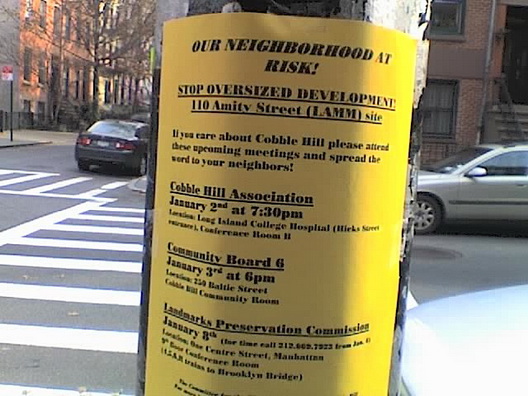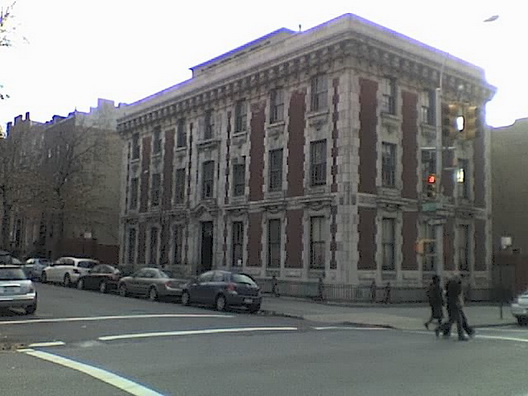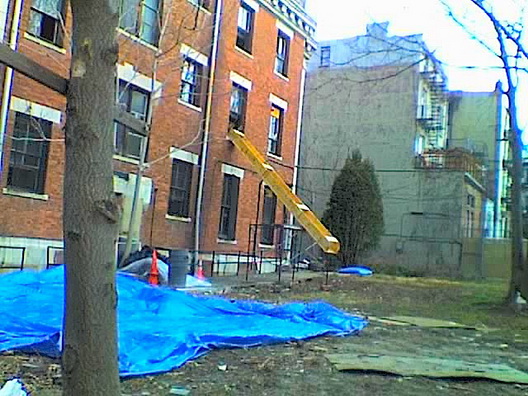
Yesterday morning, an email went out with a number of renderings of the building proposed for 110 Amity Street (Amity and Henry) in Cobble Hill. The email said, in part:
The local community is vehemently opposed to this development that changes the block structure around to create a gated community shoe-horned into the block only to maximize profit. They call it a “mews”. The plans will be submitted to CB6 January 3 at 6pm at 250 Baltic Street. Please circulate this and tell everyone you know. Please come if you are able to. Following this meeting, the project is scheduled to be presented for approval at the Landmarks Preservation Commission on January 8 (time to be specified).
Back in December, Brownstoner called it a possible “Amity Street Horror.” The developer, Time Equities, would put an addition atop an historic 1903 building and build six very large “town houses” next door. Chances on this one getting through unscathed or not causing deep bitterness in the community: Zero.




3 responses so far ↓
1 Anonymous // Jan 3, 2008 at 8:21 am
I love this building and the one across the street from it. My Mother, a nurse from the old Belleview School of Nursing. When I would walk past, I used to imagine the nurses from 1900 and their starched caps atop their heads fixed with bobbi pins, fighting the winds from the harbor whipping up their white uniforms. As far as this “renovation” goes, I knew it when the red fence was repaired and a gate installed. I wondered why there had never been a garden there or a common area over the years. This rendering, though hard to discern, appears to leave most of the exterior details intact. There is intricate carving around the front door, but, the original door is long gone, so, I wonder if the designer will feel the need to retain the carving or be creative enough to compliment the neighborhood by adding a resonable facsimile of an old, carved Cobble Hill door. The mews idea is a wondeful attempt at complimenting the neighborhood. A short block away are the fantastic Workman’s Cottages on Warren, built for the families of the men building the Brooklyn Bridge. FINE example of a mews. Though, the mews depicted here resemble those low brick mews-like structures on Prsident between Columbia and Van Brunt. Characterless, gated with a strip of sod between the buildings. Love Lane isn’t gated and I don’t see mobs of youth destroying property. Workman’s has a gate but it is usually open and there is no looting or defacement of property. So, with your admirable intentions intact, Time Equities, why not rework the brickwork, loose the gate, make the place not look like it fell from the sky? And it’s also hard to tell from this rendering what is to be done with the pergola atop the old LAMM building. This sports a nice collonade of Ionic columns but too hard to see from the the street what it encloses. Will these columns be trashed? The meeting will be most interesting.
2 Anonymous // Jan 3, 2008 at 8:01 pm
The Amity Street people declined to attend the meeting.
3 Francis Greenburger, CEO and Chairman, Time Equities Inc. // Jan 23, 2008 at 10:24 am
Time Equities and its partner Lucky Boy do not want to present a project that does not have community support. We thought the mews approach did because it was supported verbally and in writing by a number of community residents and local architects based on meetings we held in November and December. The mews design was also recommended for approval by the Landmarks staff who reviewed the plan.
It may be that some community members who took issue with the mews did not attend these meetings. The benefit of the Landmark process is that it gives all stakeholders a chance to be heard. Several concerns that arose at the meetings led to changes.
We value feedback from the community and the commission and will continue to address concerns, such as those that arose in the early meetings which led to design revisions of the Henry Street façade of the new townhouse.
At this point, we will re-conceive the project in a traditional street wall approach and try to present a plan that is responsive to the input received at the most recent Landmark hearing. As we did last time, we will reach out to the community and Landmark staff prior to presenting the final concept to the commission.